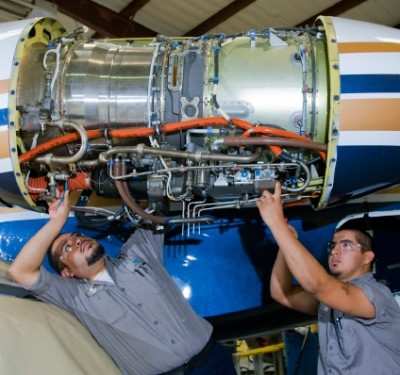Wed, Oct 21, 2009
54th Aircraft Is In The Modification Process
 Since Sierra Industries was awarded an STC for the first FJ44
upgrade – the Eagle II – in 2002, the fleet has grown
to a total of 54 aircraft. The high-performance mix of Citation I,
II and S-II aircraft have amassed a total of more than 50,000 hours
of Williams engine operation with no mechanical problems. The 54th
Citation is currently being retrofitted with Williams FJ44
turbofans.
Since Sierra Industries was awarded an STC for the first FJ44
upgrade – the Eagle II – in 2002, the fleet has grown
to a total of 54 aircraft. The high-performance mix of Citation I,
II and S-II aircraft have amassed a total of more than 50,000 hours
of Williams engine operation with no mechanical problems. The 54th
Citation is currently being retrofitted with Williams FJ44
turbofans.
Most of the aircraft are also participating in Williams’
Total Assurance Program (TAP), the industry’s leading engine
maintenance program. In the 2009 Aviation International News
product support survey, Williams won top honors for both their
engines and for their TAP maintenance program. The TAP program is
estimated to save operators more than a quarter-million dollars in
engine maintenance costs by the time TBO is reached, compared to
the original Pratt JT15D engines.
The 3rd-generation technology in the Williams powerplants also
increases efficiency, reducing fuel burn, operating cost and carbon
emissions. Since the 2002 introduction of the Eagle II, we estimate
Sierra’s FJ44 fleet has reduced worldwide carbon emissions by
more than 10,000 tons. Operators of these aircraft also enjoy
substantial performance improvements, ranging from 35 to 50 knot
cruise speed increases and 300 to 400 NM greater range to
dramatically improved climb performance. In fact, all 4 models will
easily achieve FL430 at gross weight in under 25 minutes from any
airport in North America.
Building on Sierra’s 25 years of Citation modification
history and 15 years of experience in Citation re-engining,
Sierra’s current re-engining lineup includes the highly
successful FJ44-2A powered Eagle II, Stallion and the FJ44-3A
powered Super II and Super S-II modifications. Supporting these
modifications with their extensive in-house manufacturing
capabilities, Sierra is among the largest holders of FAA Parts
Manufacturing Approvals (PMA) in the southwestern US.

Sierra has recently announced new incentives for advance booking
of 2010 modifications, reducing already industry-leading 2009
pricing. FJ44-2A Stallion upgrades start at under $1.55 million and
FJ44-3A Super II and Super S-II positions are available starting
under $1.75 million. Generous trade-in allowances are also
available on existing Pratt engines with time remaining.
More News
Aero Linx: Model Aeronautical Association of Australia MAAA clubs are about fun flying, camaraderie and community. For over 75 years, the MAAA has been Australia’s largest fl>[...]
Touchdown Zone Lighting Two rows of transverse light bars located symmetrically about the runway centerline normally at 100 foot intervals. The basic system extends 3,000 feet alon>[...]
“Discovery and innovation are central to our mission at Virgin Galactic. We’re excited to build on our successful record of facilitating scientific experiments in subor>[...]
How To Get A Story On Aero-TV News/Feature Programming How do I submit a story idea or lead to Aero-TV? If you would like to submit a story idea or lead, please contact Jim Campbel>[...]
Student Pilot Reported That During Rotation, “All Of A Sudden The Back Of The Plane Kicked To The Right..." Analysis: The student pilot reported that during rotation, “>[...]
 ANN's Daily Aero-Linx (05.02.24)
ANN's Daily Aero-Linx (05.02.24) ANN's Daily Aero-Term (05.02.24): Touchdown Zone Lighting
ANN's Daily Aero-Term (05.02.24): Touchdown Zone Lighting Aero-News: Quote of the Day (05.02.24)
Aero-News: Quote of the Day (05.02.24) ANN FAQ: Contributing To Aero-TV
ANN FAQ: Contributing To Aero-TV NTSB Final Report: Cirrus Design Corp SR20
NTSB Final Report: Cirrus Design Corp SR20




